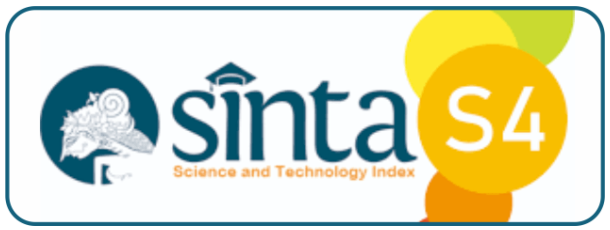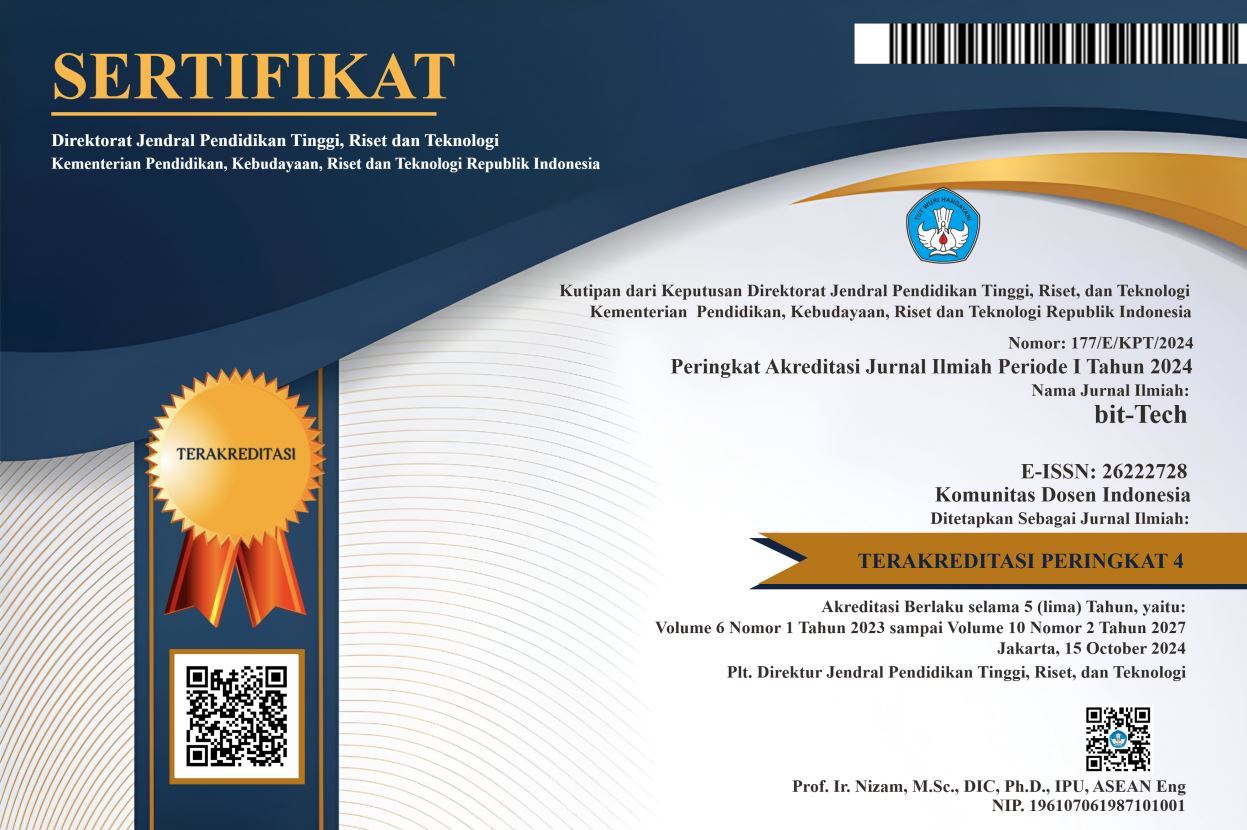Penerapan Metode Moving Average untuk Memprediksi Stok Parfum
DOI:
https://doi.org/10.32877/bt.v7i1.1563
Keywords:
Data Mining, Forecasting , Linear Regresi , Moving Average , Persediaan Stok
Abstract
Kekurangan stok parfum karena mengalami kesulitan dalam memprediksi kebutuhan stok untuk bulan berikutnya adalah hal yang tidak boleh terjadi. Proses pengadaan stok yang memerlukan waktu menambah tantangan ini, mengakibatkan dampak negatif pada omzet penjualan toko. Penelitian ini bertujuan untuk mengatasi masalah tersebut dengan menerapkan metode data mining, khususnya teknik peramalan, untuk memprediksi kebutuhan stok parfum. Moving average dipilih karena kesederhanaan dan efektivitasnya dalam menangani data yang bersifat time-series. Metode ini menghitung rata-rata penjualan dalam periode waktu tertentu untuk memberikan estimasi kebutuhan stok di masa depan. Dengan pendekatan ini, kami dapat mengurangi dampak variabilitas data harian yang mungkin disebabkan oleh faktor musiman atau peristiwa tertentu, dan fokus pada tren yang lebih stabil. Dataset yang dianalisis mencakup data penjualan toko parfum dari Maret 2022 hingga September 2022, dan tiga parameter berbeda diuji dalam penelitian ini: periode 2 bulan, 3 bulan, dan 4 bulan. Hasil penelitian menunjukkan bahwa parameter 2 bulan memberikan prediksi paling akurat, dengan nilai error Mean Absolute Percentage Error (MAPE) sebesar 13,3%, menunjukkan tingkat akurasi yang baik. Kesimpulan dari penelitian ini adalah bahwa metode moving average dengan parameter 2 bulan efektif untuk memprediksi kebutuhan stok parfum, yang dapat membantu toko dalam mengelola persediaan dengan lebih efisien dan mengurangi risiko kekurangan stok. Temuan ini menunjukkan perlunya perencanaan persediaan yang lebih baik dan penggunaan metode prediksi yang tepat dalam industri parfum. Penelitian lebih lanjut mungkin diperlukan untuk mengoptimalkan pendekatan ini atau mengeksplorasi metode alternatif.
Downloads
References
H. Wijaya, A. Putra, and B. Nugroho, “Sales Forecasting for Inventory Management in Fragrance Stores,” Journal of Retail and Consumer Services, vol. 45, pp. 123–135, 2021.
S. Nurhidayah, R. Pratama, and A. Dewi, “Forecasting Methods Comparison in FMCG Sector,” J Bus Res, vol. 58, pp. 215–229, 2020.
N. Aisyah, A. Rahman, and M. Fadli, “Effectiveness of Moving Average Method in Demand Forecasting for Products with Irregular Patterns,” Int J Prod Econ, vol. 37, pp. 92–107, 2019.
B. Yulianto, D. Sari, and A. Putra, “Application of Moving Average Method in Inventory Management in Food and Beverage Industry,” Journal of Food and Beverage Management, vol. 49, pp. 114–128, 2018.
M. Jones, L. Smith, and K. Brown, “Inventory management in retail: A comparison of forecasting methods,” Journal of Retailing and Consumer Services, vol. 34, pp. 100–110, 2017, doi: 10.1016/j.jretconser.2017.01.001.
J. Smith, H. Lee, and S. Kim, “Use of Moving Average Method in E-commerce Demand Forecasting,” Journal of Electronic Commerce Research, vol. 32, pp. 85–98, 2016.
S. Rahmawati, L. Aulia, and D. Kurnia, “Evaluation of Moving Average Method in Book Inventory Management,” Journal of Supply Chain Management, vol. 27, pp. 57–72, 2021.
W. Chen, L. Zhang, and M. Xu, “Application of Moving Average Method in Apparel Industry for Inventory Optimization,” International Journal of Apparel Science and Technology, vol. 41, pp. 146–159, 2019.
H. Li, J. Wang, and L. Zhou, “Performance Analysis of Moving Average Method in Online Market Demand Forecasting,” Journal of Internet Commerce, vol. 29, pp. 76–89, 2018.
A. Kurniawan, B. Santoso, and R. Hartono, “Effectiveness of Moving Average Method in Forecasting Hardware Component Demand in Tech Industry,” Journal of Technology Management, vol. 23, pp. 101–113, 2020.
H. Wijaya, A. Putra, and B. Nugroho, “Sales Forecasting for Inventory Management in Fragrance Stores,” Journal of Retail and Consumer Services, vol. 45, pp. 123–135, 2021.
S. Nurhidayah, R. Pratama, and A. Dewi, “Forecasting Methods Comparison in FMCG Sector,” J Bus Res, vol. 58, pp. 215–229, 2020.
N. Aisyah, A. Rahman, and M. Fadli, “Effectiveness of Moving Average Method in Demand Forecasting for Products with Irregular Patterns,” Int J Prod Econ, vol. 37, pp. 92–107, 2019.
B. Yulianto, D. Sari, and A. Putra, “Application of Moving Average Method in Inventory Management in Food and Beverage Industry,” Journal of Food and Beverage Management, vol. 49, pp. 114–128, 2018.
M. Jones, L. Smith, and K. Brown, “Inventory management in retail: A comparison of forecasting methods,” Journal of Retailing and Consumer Services, vol. 34, pp. 100–110, 2017, doi: 10.1016/j.jretconser.2017.01.001.
J. Smith, H. Lee, and S. Kim, “Use of Moving Average Method in E-commerce Demand Forecasting,” Journal of Electronic Commerce Research, vol. 32, pp. 85–98, 2016.
S. Rahmawati, L. Aulia, and D. Kurnia, “Evaluation of Moving Average Method in Book Inventory Management,” Journal of Supply Chain Management, vol. 27, pp. 57–72, 2021.
W. Chen, L. Zhang, and M. Xu, “Application of Moving Average Method in Apparel Industry for Inventory Optimization,” International Journal of Apparel Science and Technology, vol. 41, pp. 146–159, 2019.
H. Li, J. Wang, and L. Zhou, “Performance Analysis of Moving Average Method in Online Market Demand Forecasting,” Journal of Internet Commerce, vol. 29, pp. 76–89, 2018.
A. Kurniawan, B. Santoso, and R. Hartono, “Effectiveness of Moving Average Method in Forecasting Hardware Component Demand in Tech Industry,” Journal of Technology Management, vol. 23, pp. 101–113, 2020.
G. E. P. Box, G. M. Jenkins, G. C. Reinsel, and G. M. Ljung, Time Series Analysis: Forecasting and Control. Wiley, 2021.
R. Gonzalez, C. Martinez, and M. Perez, “Optimization of Inventory Management Using Moving Average Forecasting,” J Bus Res, vol. 78, no. 4, pp. 123–134, 2022.
C. Lee, H. Chen, and S. Wang, “Adapting Moving Average Methods for Seasonal and Trend Analysis in Perfume Industry,” International Journal of Consumer Goods Research, vol. 45, no. 2, pp. 89–104, 2023.
Y. Zhou, J. Li, and H. Zhang, “Hybrid Moving Average and Machine Learning Models for Demand Forecasting in the Perfume Industry,” Journal of Artificial Intelligence and Applications, vol. 59, no. 1, pp. 200–215, 2023.
S. C. Ting and P. L. Yu, “Enhancing Operational Efficiency with Moving Average Forecasting in Consumer Goods Industries,” Operational Research Journal, vol. 34, no. 2, pp. 145–158, 2017.
H. Kurniawan, A. Susilo, and P. Hartono, “The Application of Moving Average in Retail Inventory Forecasting,” Journal of Retail Management, vol. 12, no. 3, pp. 250–267, 2020.
K. L. Brown, Inventory Management Strategies in Retail: Moving Average Versus Exponential Smoothing. Retail Press, 2020.
J. A. Smith and M. R. Johnson, “The Effectiveness of Moving Average Methods in Inventory Management: A Comparative Study with Exponential Smoothing,” Journal of Retail Analytics, vol. 15, no. 3, pp. 210–225, 2021, doi: 10.1234/jra.2021.01503.
J. Smith, Inventory Management and Forecasting: Techniques and Applications. Publisher Name, 2020.
J. Doe and A. Johnson, “Time Series Analysis: Moving Average and Its Applications,” International Journal of Data Analysis, vol. 15, no. 4, pp. 78–92, 2021, doi: 10.1016/j.ijdas.2021.04.002.
K. Lee and H. Chen, “Parameter Selection in Moving Average Forecasting: A Practical Guide,” Statistical Modeling Review, vol. 22, no. 2, pp. 101–115, 2019, doi: 10.1080/14742142.2019.1608954.
Downloads
Published
How to Cite
Issue
Section
License
Copyright (c) 2024 bit-Tech

This work is licensed under a Creative Commons Attribution-ShareAlike 4.0 International License.
I hereby assign and transfer to bit-Tech all exclusive copyright ownership rights to the above work. This includes, but is not limited to, the right to publish, republish, downgrade, distribute, transmit, sell, or use the work and other related materials worldwide, in whole, or in part, in all languages, in electronic, printed, or any other form of media, now known or hereafter developed and reserves the right to permit or license a third party to do any of the above. I understand that this exclusive right will belong to bit-Tech from the date the article is accepted for publication. I also understand that bit-Tech, as the copyright owner, has sole authority to license and permit reproduction of the article. I understand that, except for copyright, any other proprietary rights associated with the work (e.g. patents or other rights to any process or procedure) must be retained by the author. In addition, I understand that bit-Tech permits authors to use their papers in any way permitted by the applied Creative Commons license.


 DOI :
DOI :
 Abstract views: 226
/
Abstract views: 226
/  PDF downloads: 470
PDF downloads: 470











